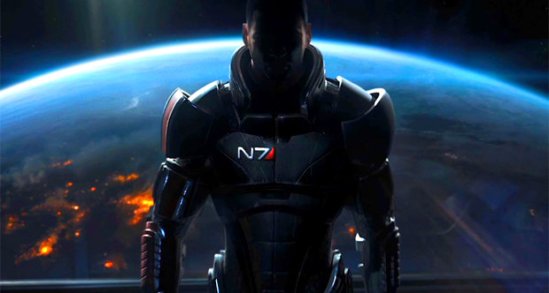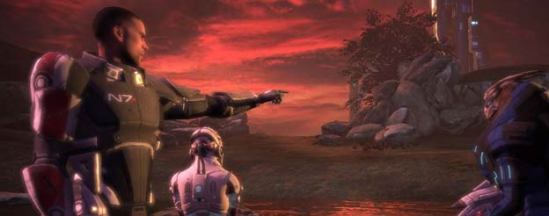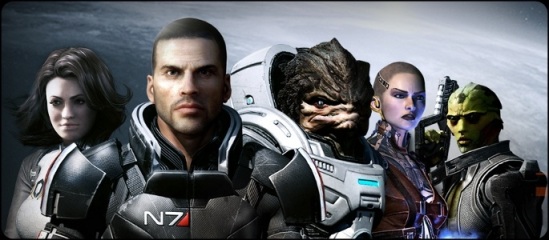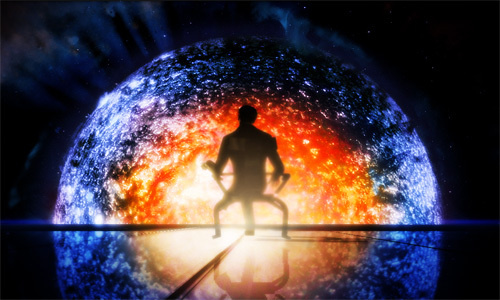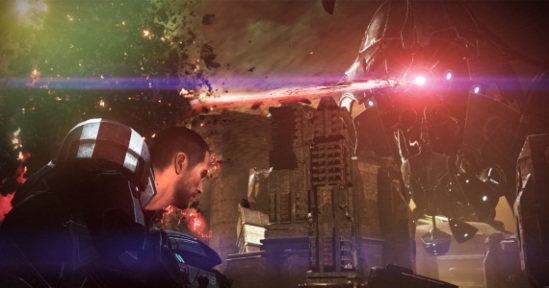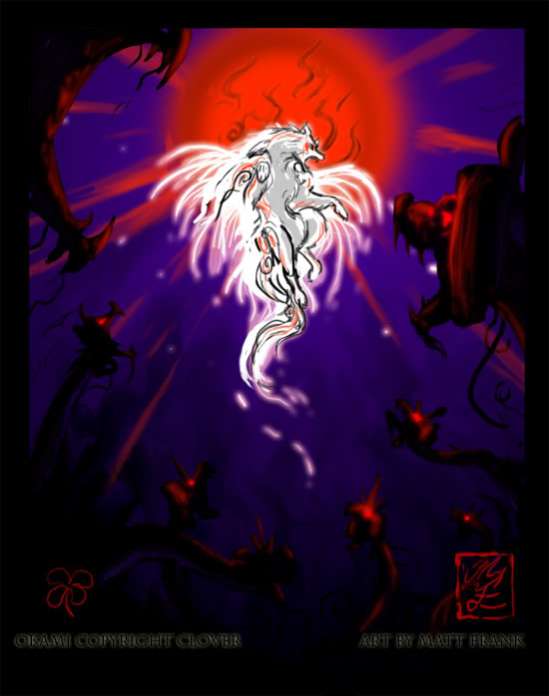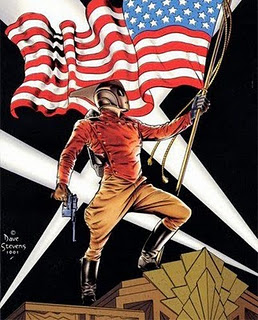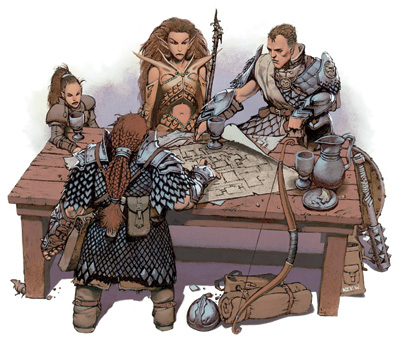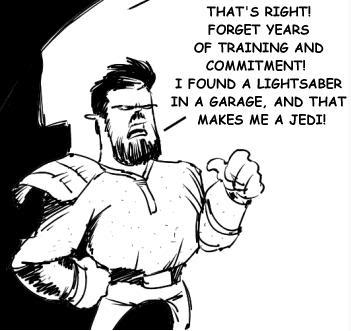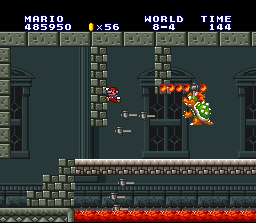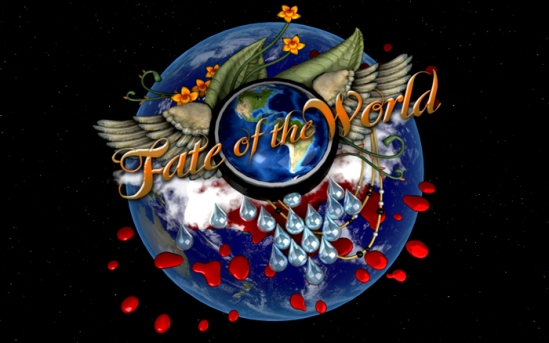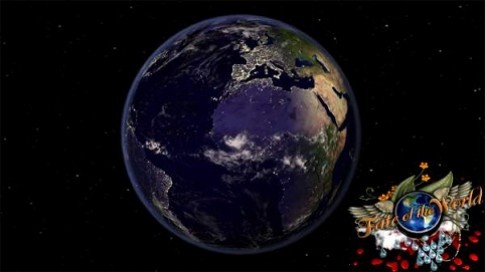In just a few weeks we’ll be seeing the third and (theoretically) final installment in Bioware’s Mass Effect series. A recently released demo gives a brief look at the story that I poked at sparingly to try to get the right balance of getting a taste and avoiding spoilers. It’ll be interesting to see how it holds up to people’s hopes and expectations.
We’re probably well past the statue of limitations, but just in case, spoilers ahoy.
The first Mass Effect (2007) was a game with a lot of big ideas and enough budget to make a decent number of them happen. The goal was to give the player an entire galaxy to explore and lots of interesting opportunities to roleplay in it. In traditional Bioware form the player joins a powerful secret society and gathers eclectic allies to bring two at a time to confront a nebulous threat of tremendous scope and possibly get hooked up with a party member. It’s the same story they always tell, but they tell it well (usually).
There’s no denying that they didn’t quite hit all the bases they wanted to. For a Bioware game it seemed kind of small at times; there were only a handful of ‘towns’ and large non-copy-pasted adventure areas. There’s a lot of side missions but an exhausting majority of them involve driving around craggy landscapes to go into near-identical buildings and shoot near-identical mercenaries.
At the same time, a lot of love went into this game. Even though you can only land on one square mile of one planet in each star system, every single planet in the game was given a neat bit of tasty flavor text. Those who enjoy crunchy sci-fi technobabble to chew on found their codex continually filling with new snacks. The moral choice system suffers at times from being forced to fit all the decisions onto a binary good/evil axis but a handful of the decisions made me put down the controller and think for a minute. The various alien worlds could have more detail, but what they do have is impressive.
There was this one time I was driving all over some craggy landscape or another, for the most part as generic as the last. Sometimes they’re blue, sometimes they’re white, sometimes there’s green dust motes around. Just for the heck of it I looked up as I crested a hill and saw a great red boiling sun hovering low in the sky. Just sat there watching it for a bit because it looked neat. I’m not 100% certain but it looked like this wasn’t just some animated image. It looked like someone had taken the time to make a realistic physics object of the swirling boiling burning gas clouds. The game is full of stuff like that, shadows cast by the game they wanted to make.
I got pretty well absorbed into Mass Effect 2 (2010), possibly due in part to three feet of snow dropping on my house every few days when I got it. Inbetween waiting for my xbox to cool off and tunneling my way out to my driveway I found a game like an oreo with really terrible stale cookies around an incredibly delicious creamy filling.
Instead of a band of heroes, this time around I filled my squad with an interesting bunch of mercenaries and socipaths. Dangerous people, but hopefully I could make them more dangerous to my enemies than to myself. The various recruitments and the side missions to secure their loyalty were my favorite part of the game, each one seasoned with interesting choices, diverse environments, and good quality Bioware storytelling. In particular the character of Jack (Courtenay Taylor) has some of the best writing and voice acting I’ve seen in a game.
While I disagree with how they got Shepard away from his old crew and ship and such I think the end result, as far as giving the story somewhere new to go with old crewmates, was pretty good. Just think of a friend you used to see every day who moved away and then you didn’t see him at all for years. In two years someone can come back a completely different person. In Garrus’ case there was a stretch during his loyalty mission where I thought he might actually shoot me.
The best part of Mass Effect 2 unfortunately also serves to highlight some of its worst parts. Many good stories are told about Shepard’s crew, but on the whole everything more happens around him than to him. In part 1 he learned about the Reaper threat and stepped up to do something about it, growing from a military squad commander into the role of a heroic leader by the end of the game. In part 2 he’s in the same place at the beginning as at the end; the Reapers are still coming, the council still doesn’t want to help, and there’s still no concrete defense to be mounted.
A majority of the game’s problems can be summed up in one word: Cerberus (and if one were to add a second word, the Collectors). The weakest parts of the game are easily the beginning and ending where everything has to be contorted to shoehorn these plot elements into place. It doesn’t make sense to force the player to join an organization that in ME1 was only slight less effective than Cobra Commander, especially with the Shadow Broker already established. Same goes for some of your former crew to sign on with terrorists on the vague justification that Cerberus is composed of numerous cells and some of them aren’t so bad. Nor is it necessary to vaporise Shepard and then resurrect him with soft science magic all in the first five minutes of the game when there’s about a dozen easy ways for someone to disappear for two years in the far reaches of space.
And then there’s the ultimate goal of the Collectors; turning humans into goo to build a giant robot shaped like a human to ride inside a space squid robot makes the Matrix human battery system seem downright reasonable by contrast. The big final decision of whether to blow up the giant enemy facility choc full of extremely valuable technical data on Reaper/Collector defenses or to hand it over to the terrorists is similarly goofy.
Hypothetically, here’s how I would have run Mass Effect 2. Shepard being out of contact for awhile is still useful to the plot because it gives his former crew time to go their separate ways. While out on patrol the Normandy is ambushed by a Reaper scout ship. They barely escape but Shepard goes overboard in the fighting, presumed dead. In truth he’s recovered by agents of the Shadow Broker who manage to hold him for two years before he successfully breaks out. Jacob and Miranda are SB agents who defect (or do they?) to help Shepard escape (or to monitor him). On his way out he finds that the Broker has been busy; two years has been plenty of time to make a trail of faked evidence painting Shepard as a rogue Spectre working for the Broker. This could facilitate the setup of Shepard reluctantly using the Broker’s intel to gather a team with the end goal of either breaking free or signing on with him full time. Trade the Collectors for new and exciting robots to blow up and replace the weird illogical ‘human reaper’ with some kind of intact superweapon to study or an advanced AI to capture. Ideally something that provides a decent boss fight and also makes some kind of progress towards the eventual third act Reaper showdown. It ain’t perfect and it’s basically a find/replace trading ‘Cerberus’ to ‘Shadow Broker and ‘Collectors’ to ‘Reapers’, but I for one would rather shoot more killer space robots than annoying bug monsters.
Now, you may look at all that above and think I hated this game, and there’s plenty wrong with it, but there’s plenty right too. The sloppily handled framing device is thankfully a very small part of the experience, a majority of which I spent doing stuff I liked rather a lot. It’s a little more of an action game with rpg elements than a full rpg, but the combat engine took some big strides from one game to the next. There’s also some tougher decisions to make, especially during the loyalty missions when you don’t know for certain if your actions will jeopardize the primary mission. The final mission (right up until the finale, anyway) was also an interesting series of tactical decisions that simultaneously solved the usual rpg plothole of ‘why doesn’t my entire team fight the last boss together’.
And that brings us to part 3 coming early this March and to be honest I could kinda go either way on it. Like a lot of folks I’m likely to pick it up pretty early on simply because of the momentum of playing the first two acts and I want to see the finale. Got a fair bit of worries though.
1) Bioware telling that one story over and over again gets even more obvious when they tell it back to back with the same character. Hopefully they’ll stretch out a bit the third time around.
2) I was disappointed with how Shepard’s importance changed from ‘because he knows about the Reapers’ in ME1 to ‘because he can singlehandedly beat up the entire invading alien army’ in ME2. The premise of ME3, that Shepard is a public icon who can diplomatically (or intimidatingly) rally the galaxy to work together, is something I can get behind. The demo, however, seems to be going the ‘badass super soldier’ route in which the galaxy’s only hope is Shepard punching all the bad guys in the throat. So, we’ll see how that goes.
3) It could be quite a challenge to get a cohesive story together for the finale of a series founded on having the player make meaningful decisions and still make the dialogue all work. My Shepard isn’t your Shepard isn’t his Shepard isn’t her Shepard. I have a feeling some folks are gonna find their avatars acting out of character to try to appeal to everyone.
4) I really hope a solution to the Reaper problem comes up more complex than ‘shoot them a lot’. After establishing early on that a single Reaper can nearly decimate the main battle fleet at the Citadel, it seems like when a few hundred or thousand show up something other than a direct suicide charge is required.
5) I dunno about the rest of you but I’m looking forward to having ME3 be another season of the best tv show that never existed, Wrex & Garry: Buddy Cops.
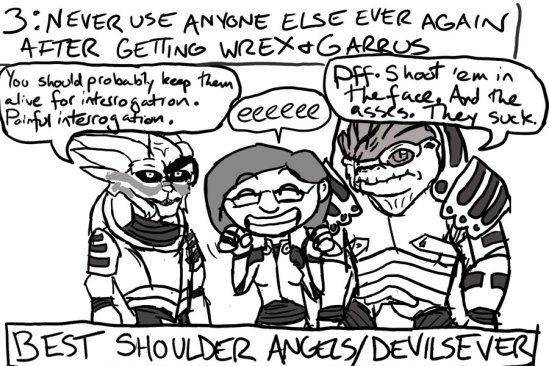
Image credit to anniezard, who draws neat stuff about Mass Effect and other cool things.

